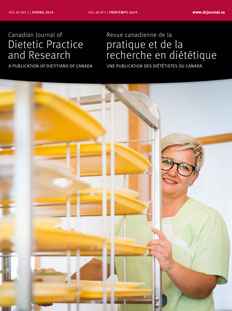Abstract
Purpose: The purpose of this study was to determine the opinions and reported nutrition practices of Canadian Registered Dietitians (RDs) with regard to feeding patients with severe sepsis.
Methods: In 2017, surveys were sent to 112 eligible Canadian RDs in 10 provinces who were practicing in an intensive care environment. The survey included embedded branching logic questions developed to address major facets of sepsis, critical illness, and nutrition. The survey instrument assimilated all data in an anonymous manner, so respondents could not be linked to their answers.
Results: Of the 64 RDs who responded (57% response rate), the majority practiced in adult intensive care (81%), within an academic center (59%), and in a mixed unit (73%). A wide variability of Canadian RDs’ opinions and practice was reported in determining energy requirements, enteral nutrition (EN) practice, EN with vasoactive agents, parenteral nutrition (PN), and supplemental micronutrients.
Conclusions: Practice variability of Canadian RDs likely reflects gaps in both evidence and guidelines for severe sepsis. Further research efforts are needed to customize nutritional requirements in the patient with evolving sepsis, EN with patients at high risk for gastrointestinal dysfunction, optimizing PN, and the role of micronutrients.
Résumé
Objectif. L’objectif de cette étude était de déterminer les opinions et les pratiques de la nutrition déclarées des diététistes canadiens en ce qui concerne l’alimentation des patients atteints d’une septicémie grave.
Méthodes. En 2017, des sondages ont été envoyés à 112 diététistes canadiens admissibles des 10 provinces qui pratiquaient dans une unité de soins intensifs. Le sondage comprenait des questions intégrées à enchaînement logique conçues pour aborder les facettes importantes de la septicémie, des maladies graves et de la nutrition. L’instrument de sondage récoltait anonymement toutes les données, d’une manière telle que les répondants ne pouvaient être identifiés à partir de leurs réponses.
Résultats. Parmi les 64 diététistes qui ont répondu (taux de réponse de 57 %), la majorité pratiquait dans une unité de soins intensifs pour adultes (81 %), dans un centre universitaire (59 %), et dans une unité mixte (73 %). Une grande variabilité quant aux opinions et pratiques des diététistes a été rapportée relativement à la détermination des besoins énergétiques, aux pratiques d’alimentation entérale (AE), à l’AE avec des agents vasoactifs, à l’alimentation parentérale (AP) et à la supplémentation en oligo-éléments.
Conclusions. La variabilité dans la pratique des diététistes canadiens reflète probablement le manque de données probantes et de directives sur la septicémie grave. D’autres efforts de recherche sont nécessaires pour personnaliser les besoins nutritionnels des patients atteints d’une septicémie en évolution et l’AE chez les patients à haut risque de dysfonctionnement gastro-intestinal, pour optimiser l’AP et pour déterminer le rôle des oligo-éléments.



